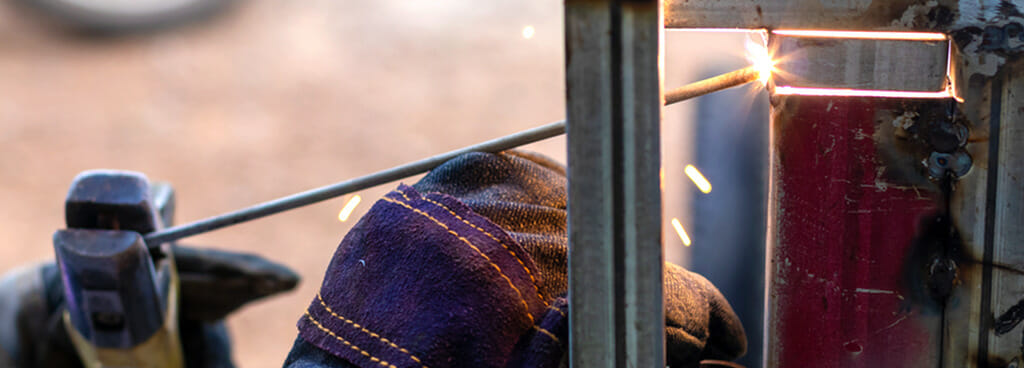- Home
- Services/IndustriesServicesindustries
- About Us
- LocationsStatesAccordion ContentAccordion ContentAccordion ContentAccordion Content
- Job Openings
- Quick Links
- ATS Family

Stick Welding Certification
Applied Technical Services offers a wide range of training and certification courses and programs, including stick welding certification. A shielded metal arc welding (SMAW) or stick welding certification proves a welder can deposit a professional-grade weld using the SMAW method.
Stick welding is a popular welding method among professional welders. The lightweight and portable equipment allows welders to work in various welding positions indoors and outdoors. When melting, the consumable flux-coated electrode produces a shielding gas that protects the weld from contamination as the welder guides the welding stick along a joint.
Before hiring a new welder, fabricators and manufacturers may want to confirm the welder’s capabilities. When in the field or a welding shop, professional welders must be able to work effectively with specific welding equipment while welding in various, often uncomfortable, positions. A welding certification is documented proof a welder can lay a sound and reliable weld.
How Does ATS Support Welding Certification?
A Certified Welding Inspector (CWI) from ATS can observe a welder’s process and test their welds, then recommend a welder for certification from an accrediting body, such as:
- American Welding Society (AWS)
- American Petroleum Institute (API)
- American Society for Testing and Materials (ASTM)
We run a spacious facility stocked with equipment for stick welding and other popular welding methods. Welders may bring a testing coupon or purchase one from our curated store for a reasonable price.
Our well-lit welding booths allow CWIs to observe a welder’s technique, from setting up equipment to cleaning the weld after the final pass. A seasoned CWI can recognize if a welder uses sufficient voltage to reach a desirable arc length and maintains a proper travel speed and electrode angle. The CWI will assess whether the welder follows the agreed-upon Welding Procedure Specification (WPS) for a weld that is up to code and meets client specifications.
What Makes a Good Weld?
After the weld cools, the CWI examines the weld’s aesthetics and qualities. A good weld produced by stick welding should be consistent, even, and free of obvious defects, such as:
- Contamination
- Poor fusion
- Shallow penetration
- Bubbles
- Spatter
- Slag
Quality Testing
Not all weld defects are readily apparent in a visual inspection. We use nondestructive inspection (NDI) methods to locate cracks and other defects:
- Liquid penetrant (PT)
- Phased array (PA)
- Ultrasonic testing (UT)
- Magnetic particle (MT)
- Eddy current (ET)
- Radiography
ATS performs destructive tests to uncover a weld’s limits and identify defects beneath the surface. We use destructive testing for a more thorough evaluation, allowing our experts to assess resistance to strain, stress, and loading and to determine hardness and tensile strength. We also perform bend testing, impact testing, macro-etch testing, and corrosion testing.
About ATS
ATS supports national and international industries through consulting engineering, equipment calibrations, and a wide range of inspections and testing. As a rapidly growing firm, we have multiple locations nationwide. Our Family of Companies (FoC) helps fortify our catalogue of testing and analysis services and extend our service network, enabling our experts to reach clients faster. Whether you need on-site services or can ship a product for laboratory testing, ATS provides a quick turnaround rate, thorough analysis, and comprehensive documentation from qualified experts.
Our labs hold multiple certifications from industry authorities:
To read more about our certifications and quality standards, click here.
Contact Us
Call +1 (888) 287-5227 or complete the form on this page to request welder certification testing at an ATS facility. In addition to certifying stick welding, ATS can certify other welding methods:
- Flux core arc welding (FCAW)
- Gas metal arc welding (GMAW)
- Gas tungsten arc welding (GTAW)

Request Form
"*" indicates required fields
Weld Testing Links
- 1G Weld Test
- 2F Weld Test
- 2G Weld Testing
- 3G MIG Welding Test
- 4G Welding Certification
- 6G Welding Certification
- ASME Sect IX Testing
- AWS D1.1 Testing
- AWS D1.2 Testing
- AWS D17.1 Testing
- Certified Welding Inspectors
- Cut and Etch Weld Testing
- Destructive Weld Testing
- Fillet Weld Break Testing
- Fillet Weld Fracture Test
- Fillet Weld Test
- Fillet Weld Testing
- Macro Etch Testing
- Macro Etch Weld Test
- Macro Etch Weld Testing
- Pipeline Inspection Companies
- Pipe Weld Testing
- SMAW Welding Certification
- Spot Weld Testing
- Structural Steel Welding Certification
- Stick Welding Certification
- Visual Weld Testing
- Weld Engineering Company
- Weld Analysis
- Weld Bend Testing
- Weld Break Testing
- Weld Hardness Testing
- Weld Inspections
- Weld Inspections Services
- Weld Joint Testing
- Weld Notch Toughness Testing
- Weld Procedure Qualifications
- Weld Tensile Testing
- Weld Testing
- Weld Testing Services
- Weld Qualification Testing
- Welder Certification
- Welder Qualification
- Welding Certification
- Welding Certification Test
- Welding Engineering
- Welding Inspector
- Welding Test Coupon
- Welding Testing Lab
- Weld Testing Services
- WPS Qualified Welding Procedure
- WPS Welder Qualifications
